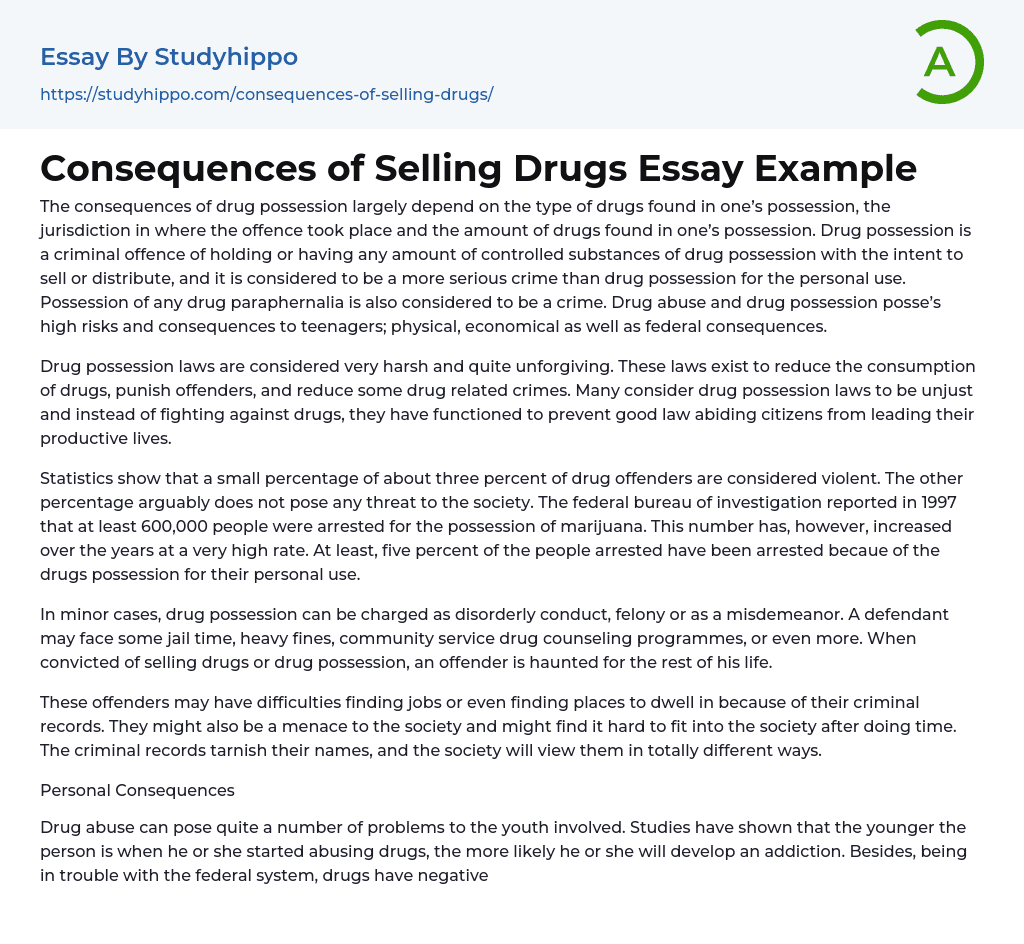The consequences of drug possession largely depend on the type of drugs found in one’s possession, the jurisdiction in where the offence took place and the amount of drugs found in one’s possession. Drug possession is a criminal offence of holding or having any amount of controlled substances of drug possession with the intent to sell or distribute, and it is considered to be a more serious crime than drug possession for the personal use. Possession of any drug paraphernalia is also considered to be a crime. Drug abuse and drug possession posse’s high risks and consequences to teenagers; physical, economical as well as federal consequences.
Drug possession laws are considered very harsh and quite unforgiving. These laws exist to reduce the consumption of drugs, punish offenders, and reduce some drug related crimes. Many consider drug possession laws to
...be unjust and instead of fighting against drugs, they have functioned to prevent good law abiding citizens from leading their productive lives.
Statistics show that a small percentage of about three percent of drug offenders are considered violent. The other percentage arguably does not pose any threat to the society. The federal bureau of investigation reported in 1997 that at least 600,000 people were arrested for the possession of marijuana. This number has, however, increased over the years at a very high rate. At least, five percent of the people arrested have been arrested becaue of the drugs possession for their personal use.
In minor cases, drug possession can be charged as disorderly conduct, felony or as a misdemeanor. A defendant may face some jail time, heavy fines, community service drug counseling programmes, or even more. When convicted of
selling drugs or drug possession, an offender is haunted for the rest of his life.
These offenders may have difficulties finding jobs or even finding places to dwell in because of their criminal records. They might also be a menace to the society and might find it hard to fit into the society after doing time. The criminal records tarnish their names, and the society will view them in totally different ways.
Personal Consequences
Drug abuse can pose quite a number of problems to the youth involved. Studies have shown that the younger the person is when he or she started abusing drugs, the more likely he or she will develop an addiction. Besides, being in trouble with the federal system, drugs have negative effects on an individual health, affect the academic performance; the relationships also suffer from them, while friends and family members suffer from the consequences of the offenders.
Drug abuse can also cause a great deal of emotional strains and emotional problems. These problems are anxiety, depression; mood swings, suicidal thoughts, and schizophrenia. Among the teenagers with depression problems, a high percentage reports on the use of substance and drug abuse. Teenagers who use marijuana have a double risk of suffering from depression and anxiety, as proven by tests and statistics.
Dropping out of school, absence in class, declining grades - these are some of the problems that are associated with the drug abuse. Hawkins Catalona’s and Miller’s (2009) research indicate that high truancy and low level commitment to education is highly connected to the substance abuse among teenagers. Drugs, usually, if not all times, damage the short term and long term memory of students. This interferes
with their learning in the immediate and distant academic future. Behavioral and cognitive problems faced by alcohol and drug abusing youth interfere with the performances of students and pose a threat of destruction at fellow classmates.
During the alcohol and drug abusing, the youth face high risks of death through homicides, accidents, suicides and illnesses. Accidents caused by drunk drivers or overdosing pose a threat to lives of those involved. They suffer from physical disabilities as a result of abuse of these substances and mental illness. They also cause brain damages, which result to the permanent or irreversible mental disorders and damage the nervous system. Brain damage among teenagers include brain shrinkage, amnesia, impaired learning abilities, and impaired reasoning, increased or decreased socialization, impaired perception and changes in sexual desire.
- Abuse Support essays
- Child Abuse essays
- Alcohol Abuse essays
- Physical Abuse essays
- Sexual Abuse essays
- Substance Abuse essays
- Animal Cruelty essays
- Law Enforcement essays
- Juvenile Justice System essays
- Surveillance essays
- Forensic Science essays
- Crime Prevention essays
- Criminal Justice essays
- Criminology essays
- Drug Trafficking essays
- Juvenile Delinquency essays
- Organized Crime essays
- Penology essays
- Prison essays
- Property Crime essays
- Punishment essays
- Serial Killer essays
- Sexual Offence essays
- Victim essays
- Crime scene essays
- Punishments essays
- Charles Manson essays
- Juvenile Crime essays
- Piracy essays
- Stealing essays
- Gang essays
- Hate Crime essays
- Homicide essays
- Damages essays
- Murder essays
- Robbery essays
- Ted Bundy essays
- Prostitution essays
- Violent crime essays
- Rape essays
- Identity Theft essays
- Sexual Harassment essays
- Distracted Driving essays
- Drunk Driving essays
- Detention essays
- Sexual Assault essays
- Sexual Assault on College Campuses essays
- Cyber Crime essays
- White Collar Crime essays
- Fur essays




